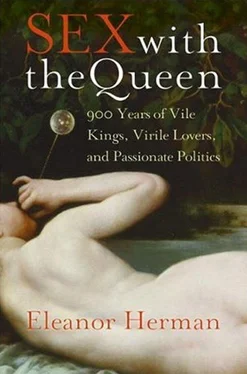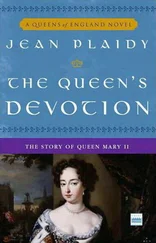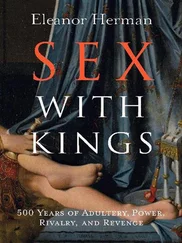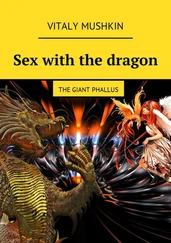Only after six years, when Henry’s divorce from Catherine was well under way and Anne the acknowledged fiancée, did she finally accept Henry into her bed. After so many years of waiting we can imagine the blessed release of that first night, the taste of her skin, the feel of his weight, the cries of pure delight in the dark. It was a providential coupling for England. Anne cleverly became pregnant immediately with the greatest monarch the nation would ever have. Desperate for a son, Henry wanted to make sure the prince Anne was carrying would be born within the sacred bonds of marriage, an undisputed legal heir. He secretly married Anne in January 1533.
A century after Henry VIII, the earl of Sandwich said, “He that doth get a wench with child and marries her afterward it is as if a man should shit in his hat and then clap it upon his head.” 17Very soon after his second marriage, Henry must have felt as if he had indeed clapped such a hat upon his head. Anne Boleyn stubbornly gave him a princess—the future Queen Elizabeth— instead of a prince. Nor was the new queen popular with the English people. There were so few cheers during Anne’s 1533 coronation that it resembled “a funeral rather than a pageant,” wrote the Spanish ambassador. 18
After her first miscarriage in 1534, Anne knew she was in trouble. Two pregnancies and no son. Henry became impatient; his small eyes narrowed when he looked at her. She tried to revert back to the role of mistress which she had played so well— sexual, scintillating, witty, despite her worry, despite her exhaustion. Yet often she cracked under the strain, letting loose a torrent of vitriol against the very man who had moved heaven and earth to place her on the throne. She hacked away at him with her sharp cleaving tongue, something which patient Queen Catherine had never done.
Thin and worn, her eyes feverishly bright, she looked older than her age. At court her sharp desperation, nervous nastiness, and sense of impending doom contrasted unpleasantly with plump sweet young things buzzing around her. And Anne noticed the king’s eye roving to her ladies-in-waiting. These ladies no longer hoped only to become the king’s mistress; they wanted to become queen. Anne had proven that a queen could easily be replaced; in her greatest victory were the seeds of her ultimate defeat.
But it was the men, after all, who proved more dangerous. On her scramble to the top Anne had alienated powerful courtiers. Sensing Henry’s growing dislike of his queen, political factions sprang into action against her. Anne was a religious reformer; there were many at court who yearned to go back to the bosom of the old church and thought that with Anne removed, the king would be so inclined. Politically, Anne was pro-French; she had been raised at the French court and hated Spain, the native land and staunch supporter of Henry’s first wife, Queen Catherine. But many at court wanted to drop the French alliance and form one with Spain.
There were those who wanted to remove Anne for reasons of pure personal greed. The cunning Seymour brothers, knowing of the king’s increasing interest in their plain sister Jane, saw riches and power coming their way as soon as Anne was gone. Those who had been displaced from lucrative court positions by Anne’s powerful family joined the fracas.
Henry, who had waited seven years in a messy divorce from his first wife to marry Anne, was now heartily sick of her and impatient to marry Jane Seymour. He wouldn’t tolerate another protracted divorce that raised questions about the legitimacy of future children. The easiest way to disencumber himself from Anne would be to charge her with a capital offense—adultery was always a good missile to sling at a queen—and have her executed. The newly minted widower could then remarry immediately.
Possibly there were more sinister forces at work than just Henry’s longing for an heir combined with Anne’s political enemies. Some modern scholars believe that the fetus she delivered in January 1536 was deformed, the surest sign of God’s displeasure in the sixteenth century. If this was true, Henry must have felt the accusing finger of God pointing straight at him. The king refused to accept the verdict; the deformed child could not have been his. Anne must have had a lover. Moreover, such abominations were Satan’s spawn. Anne must have been dabbling in witchcraft.
That theory explains why some courtiers saw Anne holding Elizabeth, a perfectly formed child, up to Henry on the day before her arrest, and arguing emotionally, perhaps trying to prove to him that she brought one well-formed child into the world and could produce another.
Accusations of adultery must always include the name of the lover, preferably a political enemy. Two Boleyn supporters controlled access to the king and would have to be neutralized immediately: Henry Norris—groom of the stool and gentleman of the privy chamber; and William Brereton—a leading gentleman of the privy chamber. While their titles sound humble, these men who handed the king his clothes or tidied up his rooms were immensely powerful. They had the royal ear and permitted or forbade entrée to the king’s apartments; it was, indeed, the highest honor to obtain such a position.
George Boleyn, Viscount Rochford, Anne’s influential brother, would also have to be removed at the same fell stroke. His wife, Lady Jane Rochford—perhaps revenging herself for his sexual neglect of her—helped the king’s case by testifying that she had seen indications of George’s sexual involvement with his sister. Two other men—the young musician Mark Smeaton and Sir Francis Weston—had good looks to recommend them as proof of the queen’s lasciviousness.
But perhaps there was another reason to choose this particular group of five. If the goal was to remove the Boleyn faction, why were the leaders, her uncle and father, not charged with incest as well? They were far more powerful than any of the five accused. Some scholars think that all of the accused may have been homosexual, a sin considered worthy of death and eternal damnation, and indeed there may be evidence that Anne’s brother and Mark Smeaton were involved with each other. Still in existence today is a book from the 1530s attacking the institution of marriage with the names of George Boleyn and Mark S. inscribed in the front. An expensive book, it may have been an unusual and somewhat inappropriate gift from the viscount to the musician.
On May Day 1536, the day when virgins danced around an ancient phallic symbol, decorating it with colored ribbons, when witches were thought to fly through the night sky on brooms, Anne’s alleged lovers were arrested. The following day, May 2, Anne herself was arrested. After a brief trial, all five men were found guilty of adultery with the queen and condemned to die.
While most people of the time readily admitted that they were hopeless sinners, the last statements made by the accused men on the scaffold seemed to indicate sins more grievous than usual. Since they were not guilty of adultery, what sins were they referring to? At his death, George Boleyn confessed that he was a great sinner whose sins had deserved death many times over. Brereton implied his innocence of the charge of adultery with the queen but guilt for some other heinous offense. “I have deserved to die if it were a thousand deaths. But the cause whereof I die, judge not,” he said. 19
Weston said his fate was a warning to others not to count on this mortal life, for “I had thought to have lived in abomination yet this twenty or thirty years and then to have made amends.” 20Poor little Smeaton had admitted under torture that he had been the queen’s lover. Nor did he deny it on the scaffold, perhaps because such a crime would have been less sinful than his homosexuality. “Masters, I pray you all pray for me for I have deserved this death,” he said. 21Norris said nothing.
Читать дальше












